SECTION A
Answer all questions in this section
1. The electrical device used to control the amount of electric current is
A. ammeter
B. rheostat
C. voltmeter
D. galvanometer
2. A calorimeter is lagged to minimize heat transfer by
A. evaporation
B. convection
C. conduction
D. radiation
3. The energy transferred from one point to another by moving charges is
A. light energy
B. electrical energy
C. sound energy
D. chemical energy
4. The part of human eye where images are formed is the
A. iris
B. pupil
C. retina
D. cornea
5. In moving coil galvanometers, the deflection produced is proportional to the
A. current passing through the coil
B. resistance of the windings
C. number of turns in the coil
D. strength of the magnet
6. Which one of the following devices can be used to study wave forms?
A. X-rays tube
B. Vaccum diode
C. Maltesecross tube
D. Cathode Ray Oscilloscope
7. Which one of the following physical quantities is measured using a beam balance?
A. Area
B. Mass
C. Time
D. Volume
8. Which one of the following liquids is more suitable for making a simple barometer?
A. Ether
B. Water
C. Alcohol
D. Mercury
9. Which one of the following can be used to detect infra-red radiation?
A. Photographic films
B. Aerials
C. Geiger-Muller tube
D. Ionisation chamber
10. The heat absorbed by a liquid to change it to vapour at a constant temperature is called
A. Latent heat of fusion
B. specific latent heat of fusion
C. latent heat of vaporization
D. specific latent heat of vaporization
11. Which one of the following changes when force is applied on a body?
i) Mass
ii) Velocity
iii) Displacement
A. (i) and (ii) only
B. (ii) and (iii) only
C. (i) and (iii) only
D. (i), (ii) and (iii)
12. In a river, turbulent flow occurs
i) at the water falls
ii) where there is a narrow opening
iii) where the river is wide and deep
A. (i) only
B. (iii) only
C. (ii) and (iii) only
D. (i) and (ii) only.
13. A liquid of mass 2kg at 100Cis supplied with 42,000 J of heat. If the specific heat capacity of the liquid is 4,200Jkg-1 K-1, find the new temperature of the liquid.
A. 220C
B. 150C
C. 140C
D. 40C
14. Which of the following is true about the function of anodes in the electron gun of the C.R.O?
i) They deflect electrons horizontally
ii) They focus electrons
iii) They accelerate electrons
A. (i) and (ii) only
B. (i) and (iii) only
C. (ii) and (iii) only
D. (i), (ii) and (iii)
15. Figure 1 shows a circuit diagram with three resistors of 3Ω, 2Ω and 2Ω.
Find the effective resistance in the circuit
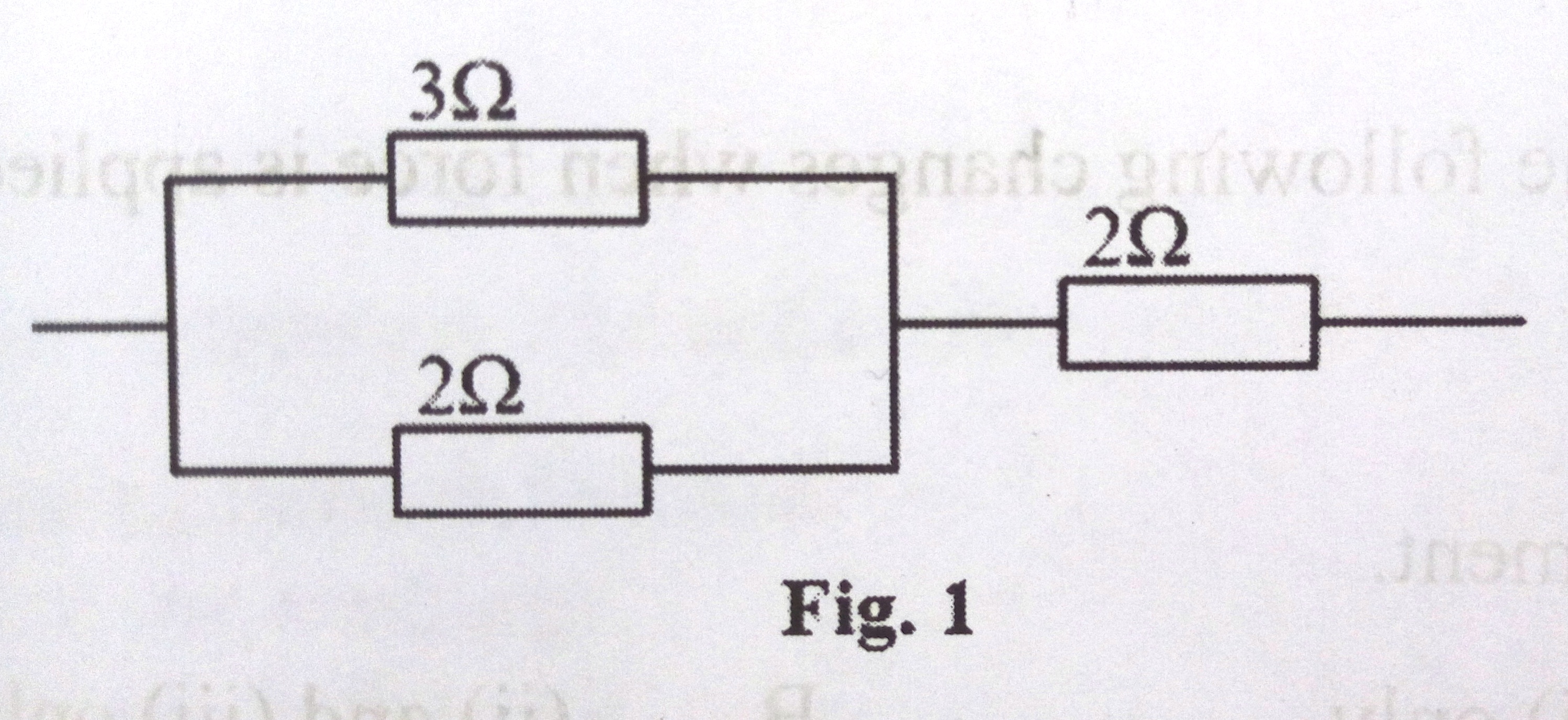
A. 1.4 Ω
B. 2.8 Ω
C. 3.2 Ω
D. 7.0 Ω
16. Which of the following is/are true about a metal ring placed near a positively charged body?
i) The ring gets charged by electrostatic induction
ii) The field lines pass through the ring
iii) The ring acts as a shield
A. (i) only
B. (ii) only
C. (i) and (ii) only
D. (i) and (iii) only
17. When an object is placed 12cm from a concave mirror, an image of height 4cm is formed at 24cm from the mirror. Find the height of the object.
A. 2cm
B. 3cm
C. 6cm
D. 8 cm
18. Figure 2 shows a wave moving through a convex section of a medium
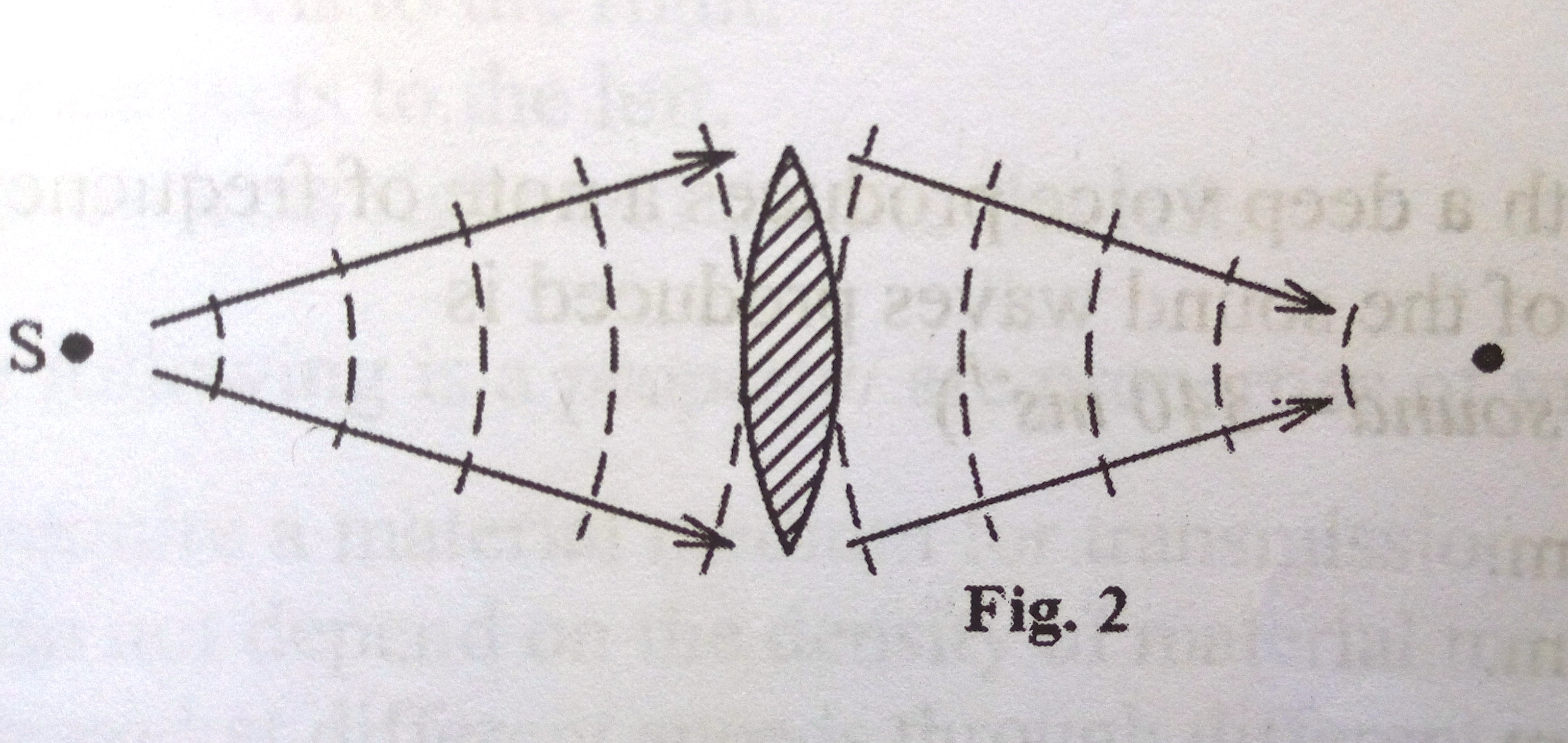
Which one of the following properties of waves is shown on the diagram?
A. Interference
B. Diffraction
C. Refraction
D. Reflection
19. An engine rated 10,000 watts raises a body vertically at a velocity of 20ms-1. Find the mass of the body in kg
A. 5.0 x 101
B. 5.0 x 102
C. 2.0 x 104
D.2.0 x 105
20. When air cells P and Q were observed under a microscope, smoke particles in P moved faster than those in Q. Which one of the following is a correct explanation for the observation above?
A. Cohesion of the air in P is stronger than that in Q
B. Air in P is at higher temperature than that in Q
C. The mass of air in P is less than that in Q
D. Air in P is denser than that in Q
21. A nuclide  decays into nuclide Y by emitting an alpha particle followed by a beta particle. Find the atomic number Y
decays into nuclide Y by emitting an alpha particle followed by a beta particle. Find the atomic number Y
A. 84
B. 85
C. 86
D. 87
22. Which of the following explains why keepers are used in the storage of magnets?
i) To prevent mutual repulsion and attraction
ii) To form a continuous magnetic loop
iii) They are hard to magnetize and retain magnetism for a long time
A. (ii) only
B. (iii) only
C. (i) and (iii) only
D. (i) and (ii) only
23. A person with a deep voice produces a note of frequency 200Hz. The wavelength of the sound waves produced is (Velocity of sound = 340ms-1)
A. 0.58m
B. 0.85m
C. 1.70m
D. 3.40m
24. In a domestic hot water supply system, the boiler is always placed at the bottom because;
A. when water is heated, it becomes less dense and rises
B. the hot water cylinder is always above the boiler
C. heating is faster when the boiler is at the bottom
D. when water is heated in the boiler at the bottom it moves up by conduction
25. A spring has a length of 0.02m when unloaded. If the length of the spring is 0.06 when a load of 2N hangs freely, find the spring constant.
A. 100Nm-1
B. 50Nm-1
C. 33Nm-1
D. 25Nm-1
26. Nuclides W,X, Y and Z are represented as 
Which of the nuclides are isotopes?
A. W and Z
B. X and Y
C. X and Z
D. Y and Z
27. Figure 3 shows a magnet moved towards a wire connected to a centre zero galvanometer. Which one of the following is correct about the movement of the pointer?

A. Pointer stays at rest
B. Pointer deflects to the right
C. Pointer deflects to the left
D. Pointer deflects right and then to the left
28. Which of the following is a property/ are properties of mechanical waves?
i) They require a material medium for transmission
ii) They do not depend on the density of material medium
iii) They travel at different speeds through different speeds through different media
A. (i) only
B. (i) and (ii) only
C. (ii) and (iii) only
29. A force of 2.0N causes a trolley to accelerate at a rate of 0.5m-2. Find the acceleration of the trolley when a force of 8.0N acts on it
A. 0.125ms -2
B. 0.500 ms-2
C. 2.000ms-2
D. 32.000ms-2
30. Which one of the following sets consists of ductile materials only?
A. plasticine, copper
B. steel, glass
C. chalk, cast iron
D. copper, cast iron
31. Which one of the following diagrams shows the correct direction of magnetic field around a conductor carrying current?

32. A body released from the top of the wall hits the ground with a velocity of 2ms-1. Find the height of the wall in metres.

33. The daily cost for using two 50W bulbs is Shs200. If 1 kWh of electricity cost is Shs400, find the time for which the bulbs are lit daily.
A. 0.20h
B. 0.50h
C. 5.00h
D. 20.00h
34. Which one of the following explains why primary coils are wound on top of the secondary coils in a transformer?
A. To allow maximum flux linkage between primary coil and the secondary coil
B. To reduce loss of heat due to change in direction of the magnetic domains
C. To reduce heat due to Eddy currents
D. To reduce heat loss due to resistance of copper wires.
35. Figure 4 shows three forces of 1N, 3N and R acting at a point O. Find the magnitude of R requires to produce a resultant force of 5N
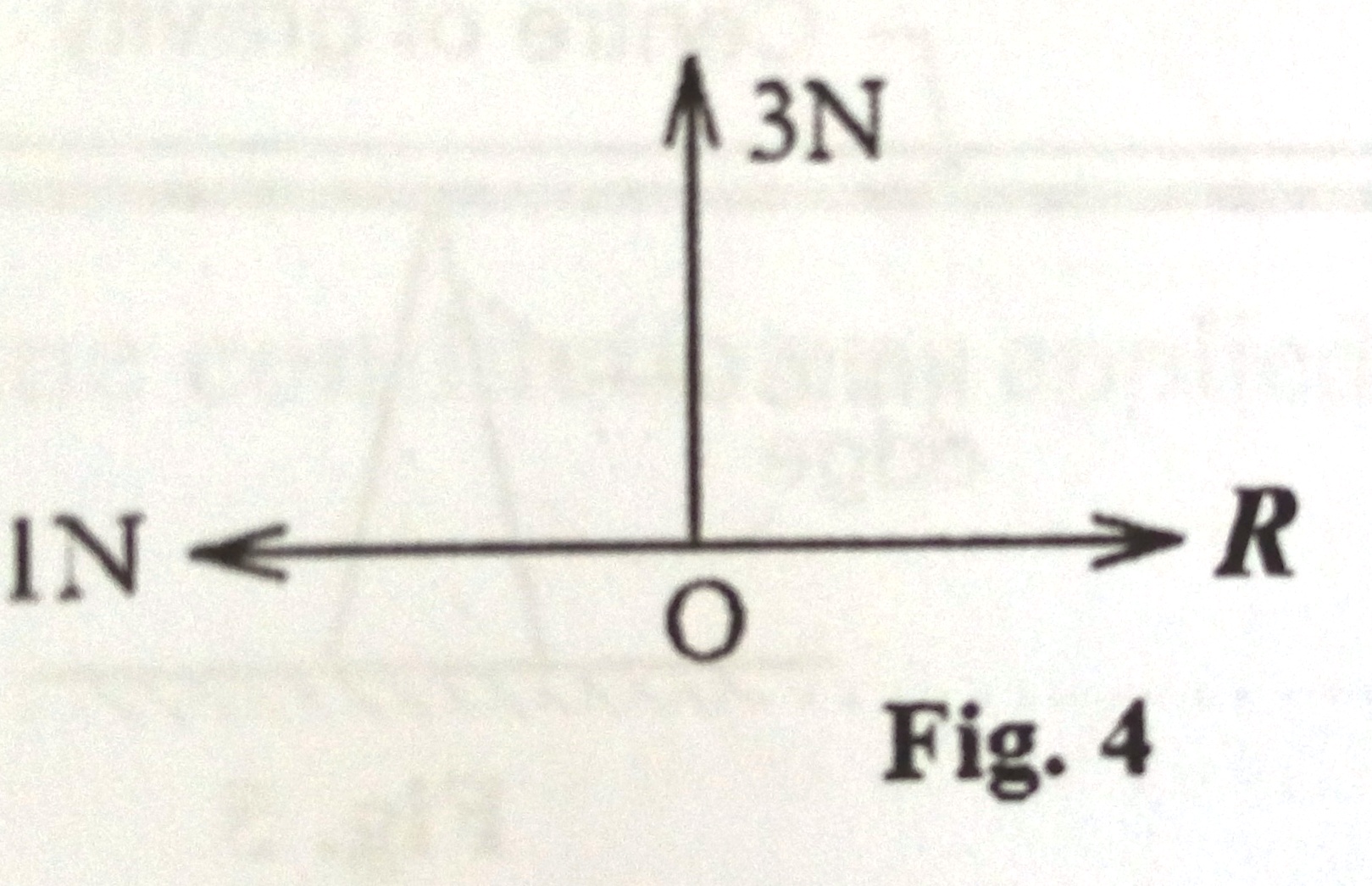
A. 1N
B. 3N
C. 4N
D. 5N
36. The energy stored in a moving body depends on its
(i) mass
(ii) volume
(iii) velocity
A. (i) only
B. (i) and (ii) only
C. (i) and (iii) only
D. (i), (ii)and (iii)
37. A breaker of mass 50g has a mass of 82g when filled with 40cm3 of a liquid. Find the density of the liquid.
A. 3.30gcm-3
B. 2.05gcm-3
C. 1.25gcm-3
D.0.80gcm-3
38. Which one of the following is a set of characteristics of an image formed by a plane mirror?
A. Real and laterally inverted
B. Virtual and same size as the object
C. Virtual and diminished
D. Real and same size as the object
39. Figure 5 shows a metre rule on a knife edge when a mass, M is hanged at one end.
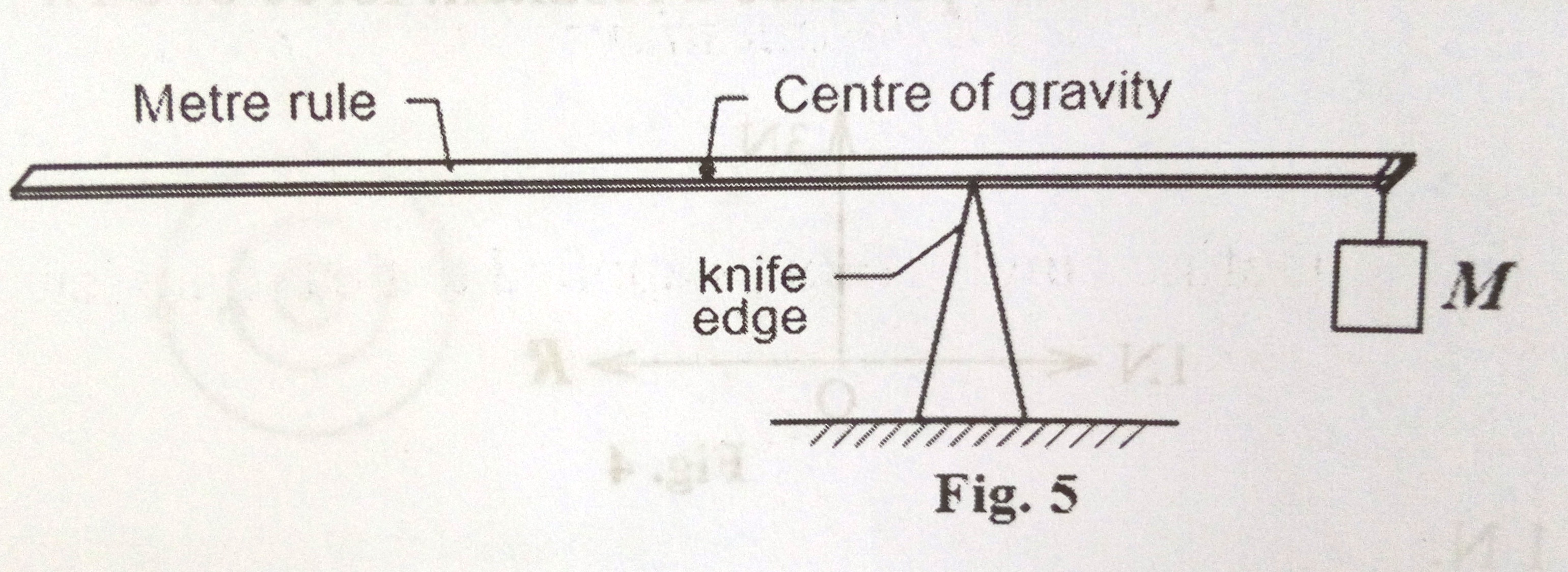
Which one of the following is true if the mass, M is moved towards the knife edge?
A. The metre rule turns in an anti- clockwise direction
B. The centre of gravity changes to another position
C. The metre rule turns in a clockwise direction
D. The metre rule remains balancing
40. The diagrams below show different containers with equal volumes of the same liquid at the same temperature. Which one of the containers will have the volume of the liquid reduced most after sometime?

SECTION B
ANSWER THE QUESTIONS IN THIS SECTION
41. a) i) Define conduction as applied to heat transfer.
ii) State any two factors that determine the rate of heat transfer by conduction along a metal bar.
b) Explain why the efficiency of heat engines is low.
42. a) State one similarity between X-rays and gamma rays.
b) How do X-rays differ from gamma rays?
c) Describe one danger and the safety measure to be taken when handling these radiations.
43. a) What is meant by focal point of a convex mirror.
ii) Explain why a convex mirror is preferred in both cases in (b) (i)
44. a) What is meant by the term heat capacity?
b) A heater rated 840W, 240V takes 50 minutes to raise the temperature of water from 250C to 850C. Calculate the
i) mass of the water (Specific heat capacity of water = 4,200 Jkg-1 K-1)
ii) volume of the water (Density of water = 1,000kgm-3)
45. a) What is meant by upthrust?
b) An iron block of mass 3.2 x 103 kg and volume 0.6m3 is totally immersed in a liquid of density 1.56 x 103 kgm-3. Find the weight of the block in
i) air
ii) the liquid
46. a) Explain why electric power is transmitted at high voltage
b) The p.d across a resistance wire is 12V. Find the quantity of electric charge flowing through the wire to generate 1.68kJ of heat energy in one second.
47. a)
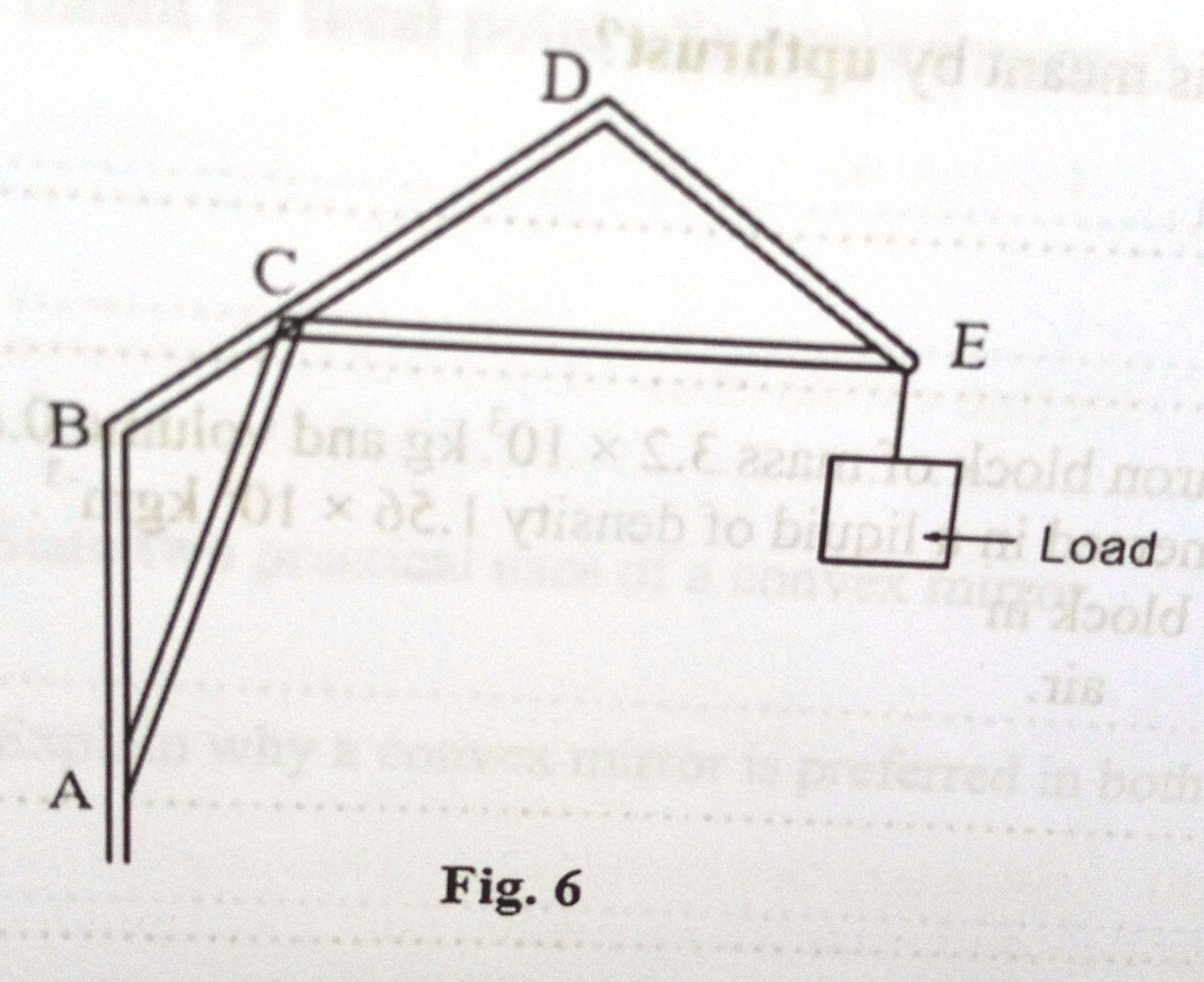
In figure 6, identify two girders under
i) tension
ii) compression
b) State two reasons why it is necessary to reinforce concrete to be used as girders
48. a) Describe how resonance is produced using an air column in a closed tube
b) Calculate the frequency of the first overtone of sound produced by a closed pipe and of length 10cm, if the velocity of sound in air is 340ms-1
49. a) Define the following
i) momentum
ii) kinetic energy
b) A trolley A of mass 5kg travelling at 9ms-1 collides with a stationary trolley B of mass 4kg. After collision they both move together at 5ms-1. Find the loss in kinetic energy.
50. a) What is a hard magnetic material?
b) A soft iron bar and steel bar are suspended inside a coil above a container of iron filing as shown in figure 7.
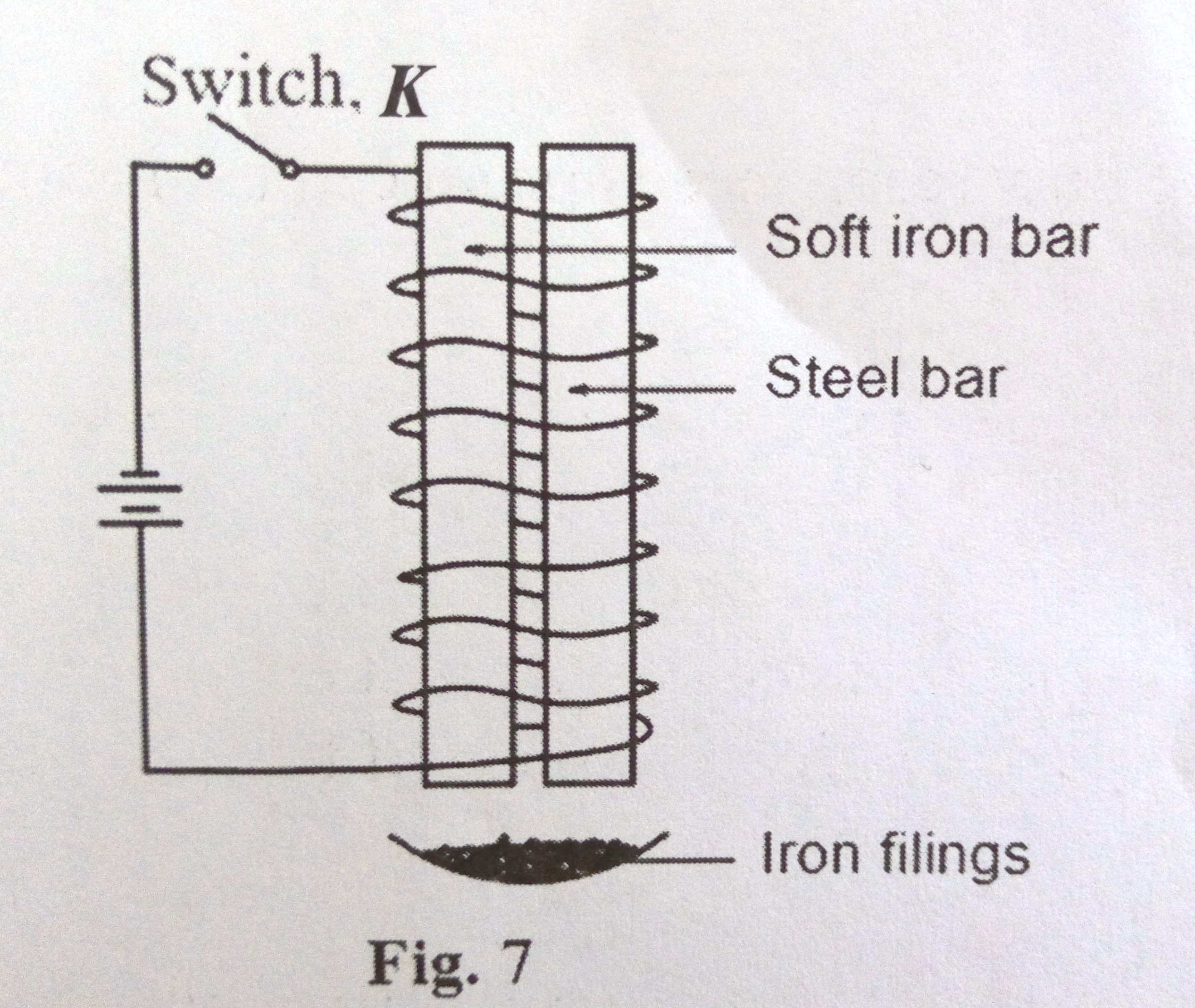
Explain what is observed when switch K is closed.
